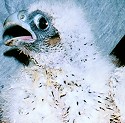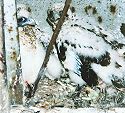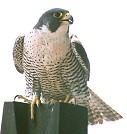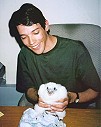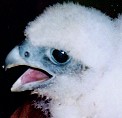|
RESEARCH |
||||
At the more easterly location we were in luck - not only were there three chicks in the nest, but they were easily accessible and were of a perfect age for banding (roughly 27-28 days). The two females weighed 672 and 715 grams (the latter due in part to a full crop), while the male was 498 grams. Though these weights are slightly on the low side, all three chicks were in good health (not to mention very good voice!). Given that their nest area is remarkably tiny (less than two square feet), it may be to their advantage to be slightly smaller than average, but even so, accommodations will soon become very crowded once the youngsters try to start flapping their wings. As at Place Victoria earlier in the month, we provided each of the chicks with an aluminum US Fish & Wildlife band on the right leg, and a black visual identification band on the left leg, then collected a feather for genetic analysis. At this site, the adult female made her presence well known from the time we arrived. She is a beautiful bird, with a clear upper breast contrasting markedly with a heavily barred lower breast. As we were leaving, we finally had a good look at her legs and saw that she is unbanded. Her mate joined in the chorus of complaints as we removed the chicks from the nest, but we never had a clear look at him. After finishing with the banding, we headed over to the second site, which involved a long climb - just what we needed on an afternoon when temperatures were well over 30 degrees Celsius! Unfortunately, the effort was for nothing - despite having been seen in the area earlier in the spring, we found no evidence to suggest that the peregrines attempted nesting this year.
June 3, 2003: Over the years, the adult female at Place Victoria has been known for her aggressiveness, and more recently this behaviour seems to have rubbed off on the male. Sure enough, walking out on to the ledge to retrieve the chicks for banding provoked quite a strong reaction - both adults were highly vocal and made several close swoops, although no contact was made. At one point the female landed only a few feet in front of me as I crouched beside the nest box, transferring the chicks into a carrying box. At that close range I was able to see that she wore only a single leg band, a silver USFWS marker on her right leg. This is in contrast to the female of past years, who had a black band instead. Without reading the full number we can't be sure of the new female's origins, but based on the absence of a colour band on the opposite leg, I suspect she is from Quebec, and may even have been raised at Place Victoria herself! All of the chicks were around 25 days old, an ideal age for banding as their legs are virtually full grown, yet their mobility is still relatively limited, making it easy to safely collect them from the nest. Also collected was an unhatched egg, which will be forwarded to the Canadian Wildlife Service's toxicology labs for contaminant analysis. Observed, but not collected, were various prey remains, mostly blue jay and pigeon. Inside, the maintenance staff kindly offered us the use of their lunch table as a working surface. The first bird banded was a large and feisty female - obviously she wasn't interested in letting us ease ourselves into the new banding season! The second bird out was a male, much more spindly-legged in comparison - and better behaved too! We finished with another female, slightly smaller than the first, and also much calmer. Each of the chicks received a standard aluminum USFWS band on the right leg, and a black visual identification band on the left leg. We also collected a feather sample from each of them to allow for genetic analysis. Altogether, the process took just under half an hour, at which point we subjected ourselves to another brief attack from the parents as we returned the chicks to the box. Our thanks to Jean Masson, Michel Beaulieu, and the maintenance and engineering staff at Place Victoria for facilitating and assisting with this banding event.
|


